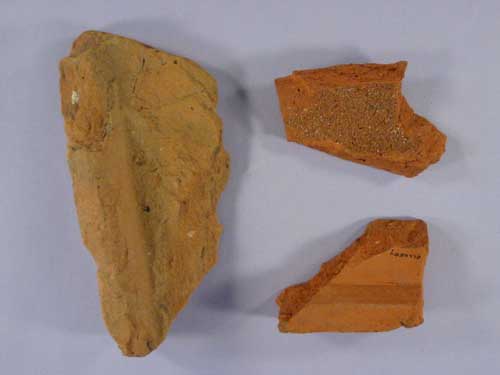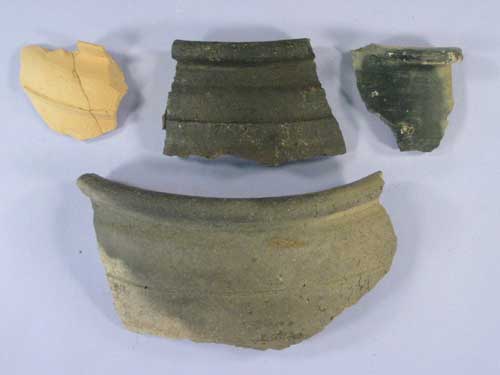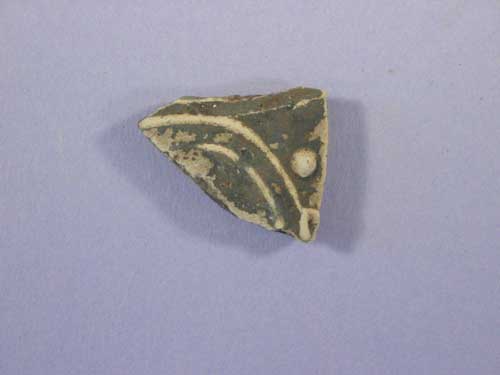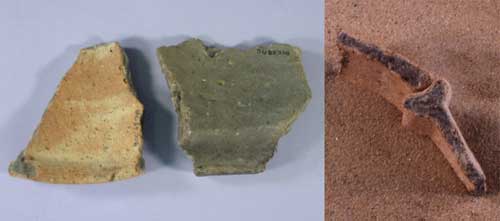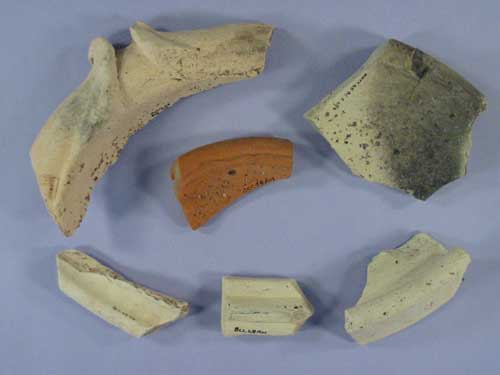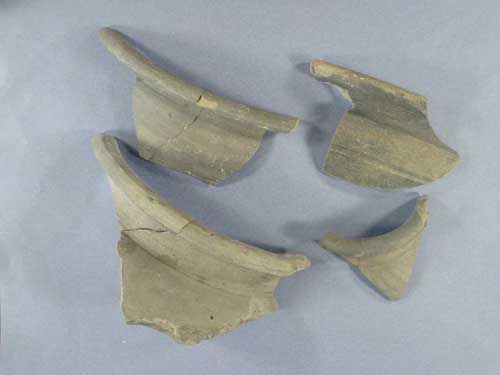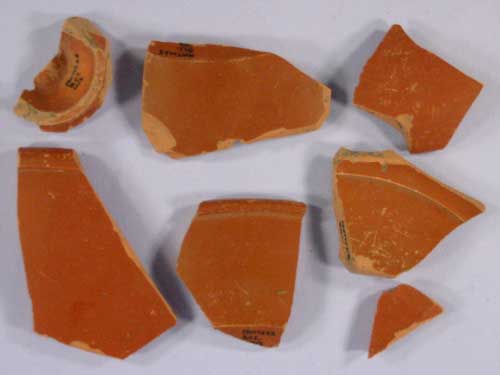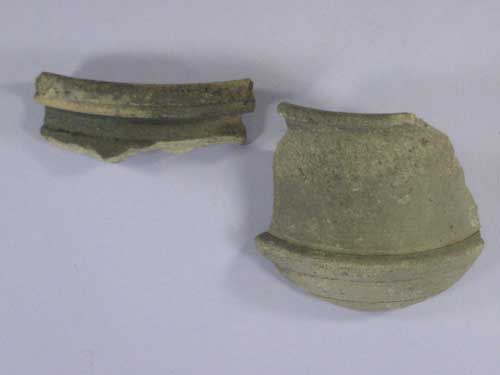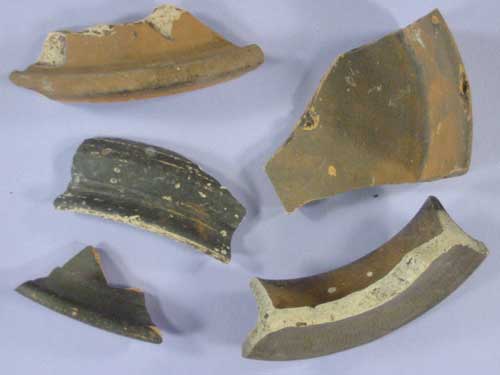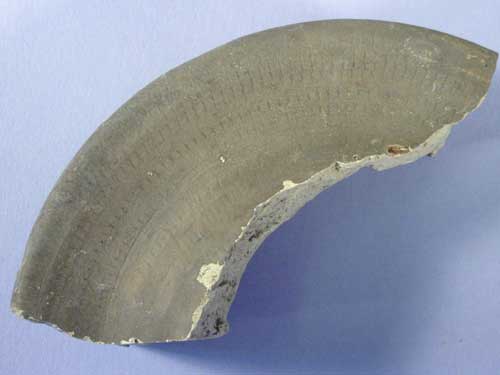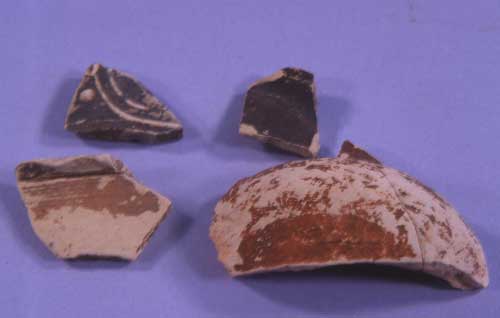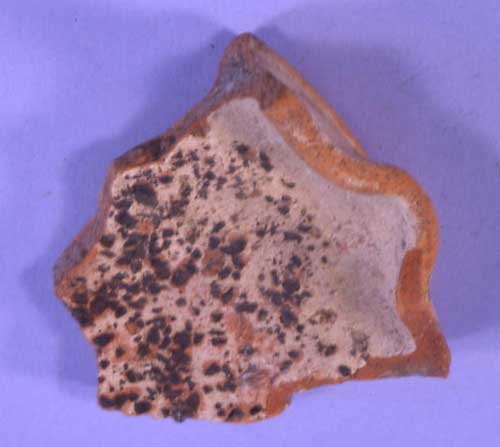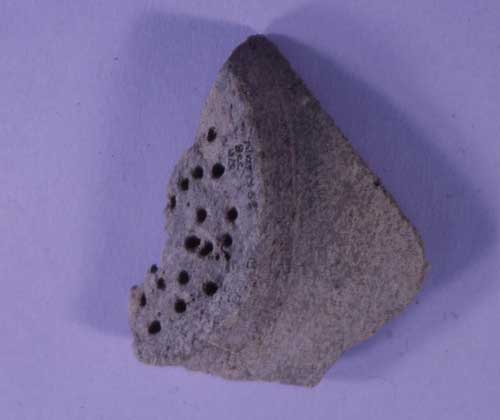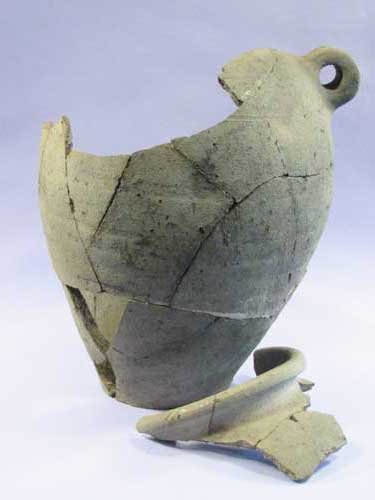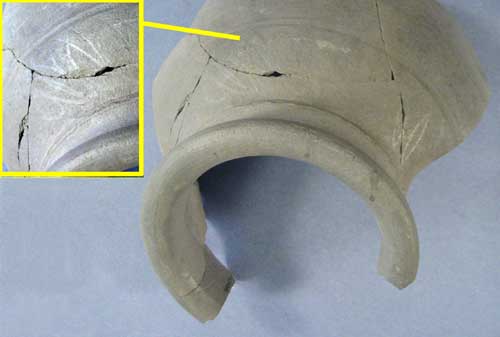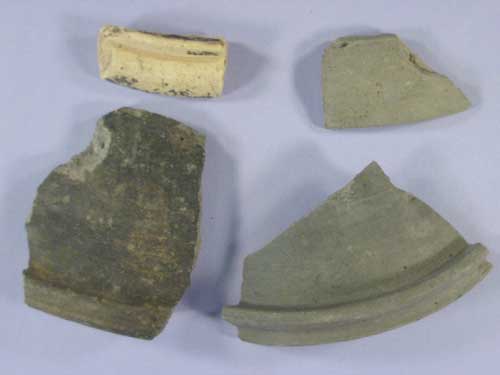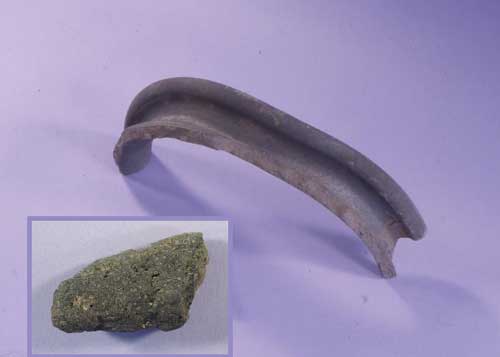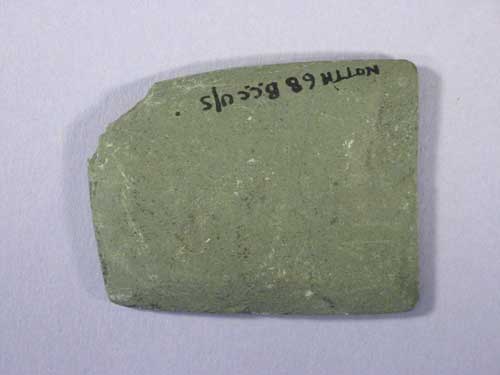![]()
HISTORY OF BINGHAM
A Roman villa at Carnarvon Primary School, Bingham
The excavation
Before the Carnarvon Primary School at Nursery Road was built in the late 1960s, contractors laying pipes for the School building discovered a skeleton and lots of Roman pottery beneath their roadway. The find was brought to the attention of Mr C. Ashton of Toot Hill School, Bingham and he began excavations on the site. Later Mr Ashton was joined by the late Tony Gregory, a native of Nottingham who first worked as a schoolboy on an excavation in Lincolnshire run by Jeffrey May of the University of Nottingham and became a well-respected professional archaeologist. The Carnarvon School excavation was the first Tony had run without supervision. He published an account of the excavations and artefacts within a year while in his first year at University. Together Mr Ashton and Tony Gregory excavated in advance of building operations. Two more skeletons were discovered in the southern part of the site, but these had been damaged by a mechanical excavator. Unfortunately no finds were associated with the skeletons so their date is uncertain.
The site
The school is built across the boundary between Triassic sandstone and clays laid down in a lake that formed about 12,000 years ago. By the time of the Roman occupation the lake had filled in to become marshland. The excavation in the late 1960s revealed a layer of grey and black clay, 4 feet (1.2 m) deep in places. This is the remains of the marsh. A great deal of broken pottery had been dumped by the Romans in this handy “landfill” site. Excavations carried out on the east side of the school in 2002, when new classrooms were being built, located the boundary between the sandstone and the clay, but overlying both was a layer about 50cm thick of mixed clay, sand, pebbles and bits of rock that was probably laid down in a flood after the Roman period.
The house
To the north of the marsh area, fragments of a ruined wall and some stone paving were excavated. Earlier ditches were found underneath the paving. The wall and area of paving may be part of a Roman house. Fragments of roof tile indicate the presence of a house with a more durable roof than thatch. One small fragment of tile was marked with a groove. Unfortunately it was too small for certain identification. However a prepossessing bag of pottery from a gas pipe trench laid in 1969 across the site found in the Store of Nottingham University Museum contained a larger fragment of tile with clear combing. Tiles with this sort of combed pattern are called flue tiles.
Very little tile or brick was
found during the excavations but these small fragments are Roman
roof tiles and tell us that a building with a more durable and
expensive roof than thatch was situated nearby.
Photo: Robin Aldworth Nottingham Castle Museum
These are shaped like a rectangular box and were embedded in the walls of rooms with under-floor heating to direct the warmth and smoke up the walls and outside at roof level. This combed pattern acted as a key for wall plaster. This demonstrates that the Roman building on the site of the school had luxury features and was most probably of villa status. Heating systems using box flue tiles were most common in Roman bath houses where people cleaned themselves by sweating out the dirt and scraping it off with a metal blade, called a strigil, then closing the pores by plunging into a small cold water bath. This is similar to bathing in a Turkish bath, rather than washing in a warm-water bath as we do.
The inhabitants of the house
The pottery from the excavations indicates people were living here in the second half of the first century AD. This early pottery includes a very fine beaker of a type found at the Roman site at Margidunum. Whoever was living at Carnarvon School obtained fine pottery of Roman type very quickly and must have been trading or exchanging gifts with the soldiers or traders at the fort there. At other local sites such as the farm at Holme Pierrepont, the native British continued to use coarse, handmade jars of a type made locally during the Iron Age. The people who first came to live at Carnarvon were either British who had adopted the fine Roman wares and developed good relationships with the occupation forces or they were the family of a Roman soldier who retired to this farm when the army moved on. Whoever they were in the first century, their descendants continued to live there until near the end of the Roman occupation of Britain in 410 AD. There are several vessels that date late in the fourth century. Two coins from the site are of mid- to late fourth century date. The mortarium from Oxford is of fourth century type and the shell-tempered rilled jars and bowls are of late fourth century date.
This group of coarse ware jars
and a fine cream beaker, all wheel-thrown, are of 1st century
date. All of these are common at the town of Margidunum and
may have been made by Roman soldiers. They are quite unlike
the coarse handmade pots found in the first century at a peasant
farm at Holme Pierrepont.
Photo: Robin Aldworth Nottingham Castle Museum
This small, rather worn fragment
is from a fine, beaker for drinking wine or other beverages.
The white marks are decorative designs curving around the body
of the beaker and were common decorative motifs on beakers in
the late second and third centuries AD. This example was made
in kilns in the Nene valley around Peterborough.
Photo: Robin Aldworth Nottingham Castle Museum
Left picture: the clay used to make these two sherds of pottery has lots of small shell fragments in it. These help the pots not to crack when they are put on or over the fire to cook food. The sherd on the left was made in kilns in Yorkshire or Lincolnshire in the third and fourth century and was very popular, perhaps initially sold as a container of oil, honey or even beer!
Right picture shows the right-hand
sherd with another sherd in the same fabric assembled as they
might have fitted together. They may have been used as a lidded
casserole set.
Photos: Robin Aldworth & Peter Allen Nottingham Castle
Museum
A range of mortaria, large bowls
used to grind or mash food. These had grits embedded in the
inner surface but standing proud to break up the food. The grits
on old mortaria are often ground smooth by constant use. The
white mortaria here have been bought from kilns near Coventry.
One of them has been burnt, perhaps in a kitchen fire. The red
mortarium is a late Roman type from kilns near Oxford.
Photo: Robin Aldworth Nottingham Castle Museum
These small sherds come from wide-mouthed
jars. Such jars were commonly decorated in a similar way to
the narrow-necked jar in 9053. The decorative zones are so similar
that they suggest that they may have been used as a set to contain
drink and foodstuff, perhaps at the table where their decoration
could be admired. They are especially common in the late third
and fourth centuries.
Photo: Robin Aldworth Nottingham Castle Museum
Imported pottery
The pottery found here includes fine red ware called samian. Samian bowls and cups were particularly popular with the Roman army officers and wealthy civilians who imported this fine tableware from Gaul (link to map showing imports from Europe in the Roman web pages) in the first, second and early third centuries AD. One of the samian sherds had a rivet hole where it had been repaired. A bowl (link to Roman home page) from Margidunum town had been repaired in fourteen places with lead rivets. This suggests that the demand for fine samian ware sometimes outstripped supply and the people had to “make do and mend”.
This fine red ware is called samian and was imported from very large
potteries in Gaul. Rather less samian has been found at the school
site compared to the pile from Margidunum but these sherds from
cups and bowls show us that the householder was able to purchase
the very best in tableware in the first and second centuries AD.
Photo: Robin Aldworth Nottingham
Castle Museum
British-made pottery
In the second century the householder bought drinking beakers from pottery kilns near Peterborough as well as coarser grey beakers made locally. Bowls, dishes, cooking pots and water pots were made in a sandy grey ware, probably locally. In the late second to fourth century when samian became scarcer, the site obtained fine jars, beakers, bowls and dishes from the kilns at Peterborough. This suggests the farmer was affluent enough buy fine tablewares. One of the water pots was very beautifully decorated with curving burnished scribbles and wavy lines. This style of pot can be found at fourth century Roman kilns excavated at Lincoln, although this vessel may have been produced locally in the same style. Other coarse ware jars were brought in from Lincolnshire, traded either as pots, or more likely for their contents, perhaps beer or honey. Other kitchen equipment, in the form of large flanged bowls, known as mortaria, used for grinding and mashing foodstuff was bought from potteries near Oxford and Coventry as well as Peterborough.
These two rim sherds are in a
common grey ware made all over the East Midlands but the rim
of the jar on the left is of a type made in kilns at Torksey
in the Trent Valley and date to the late second and third centuries.
The right hand vessel is a common beaker type during the late
1st and 2nd centuries AD. Three very similar ones were found
at Margidunum.
Photo: Robin Aldworth Nottingham Castle Museum
All these sherds are in a ware made at some very successful
kilns in the Nene Valley near Peterborough. These potteries
produced a whole range of beakers, bowls, dishes, jars and flagons
throughout the second, third and fourth centuries which were
sold all over Roman Britain as table ware. These pieces are
of late third and fourth century date and were very popular
because by that time the highly desirable red, samian
ware was no longer being imported into Britain.
Photo: Robin Aldworth Nottingham Castle Museum
This is quite an unusual type – a colour-coated lid
with a delicate rouletted decoration on top. It has a small
projection or lip below which would have slotted into the jar
or jug. This also came from the Nene Valley kilns.
Photo: Robin Aldworth Nottingham Castle Museum
All these sherds are in a ware made in the Nene Valley near
Peterborough. These potteries produced a whole range of vessels
throughout the second, third and fourth centuries which were
sold all over Roman Britain as tableware. These pieces have
been made of white clay and then dipped in a liquid clay, known
as a slip, giving a darker colour when fired in a kiln. From
bottom left, clockwise these are a beaker, another beaker sherd,
a dish and a jar.
Photo: Peter Allen Nottingham Castle Museum
This sherd is from a mortarium, or grinding bowl, and shows
a small spout which the potter has made to pour off the liquid.
This example is of a type made at kilns at Swanpool, Lincoln
in the late third and fourth centuries. Rather than using small
stones as grits they used broken up iron slag (the black bits).
The mortarium has been made in an orange sandy clay which has
been dipped in a finer grade white clay before firing, coating
the vessel. This may have been because white vessels seem to
have been particularly prized by the Romans but this was a cheaper
way of producing the same effect.
Photo: Peter Allen Nottingham University Museum
The base of this grey ware jar has been pierced with lots of
holes to use as a colander.
Photo: Peter Allen Nottingham Castle Museum
This splendid jar had pierced lugs through which suspension
ropes or basketry could be strung to suspend it above a fire,
or more probably to lower it down a well like the one found
recently at the school. These sorts of jars were used to raise
water from the wells by lowering them in a kind of harness or
tied to a rope or leather thong. Jars like this are often found
broken at the bottom of wells. The well at Carnarvon School
was sealed to protect it rather than excavated.
Photo: Robin Aldworth Nottingham Castle Museum
The decoration on this jar suggests that it was meant for
display as well as being functional. The shoulder has been richly
decorated with looping burnished lines in a zone delimited by
horizontal grooves. Such jars commonly had zones demarcated
by raised cordons (ridges) or grooves all the way down the body
to just above the base. The upper part of the body would be
decorated with burnished curves, latticed lines, intersecting
loops and shiny borders while the lower body would have combed
wavy lines, criss-cross grooves and ridges which would help
the householder to grip the pot when carrying it. This type
of jar also seems to have been used for holding water, like
a modern jug.
Photo: Robin Aldworth Nottingham Castle Museum
These four sherds are all from bowls and dishes used by
the Romans to cook and eat their dinners. The one at the bottom
left would have been a wide shallow dish, known by archaeologists
as a “dog dish” because of its shape. The other
three would have been a bit deeper and have a handy flange to
help pick up the dish.
Photo: Robin Aldworth Nottingham Castle Museum
A kiln at Carnarvon?
There is some evidence from the site for the sorts of activities being carried out there besides farming. A sherd of a lid-seated jar was so over-fired that the clay had bubbled and turned dark grey. This was a first century jar form and its condition suggests that it is a “waster” – a pot that has been misfired in a pottery kiln. Evidence from Margidunum suggests that there were pottery kilns nearby supplying the fort and town. Some of them may have been sited at the School near the clay deposits in the marshland. A second jar with a warped rim of late second or third century date may come from later kilns on the site. Sometimes farmers added to their income by making pottery when there was not as much to do about the farm. As well as pottery production, fragments of slag indicate smithing may have been carried out at the farm although this may have only been periodic for repairing farm equipment.
These two sherds are particularly interesting. The bottom sherd
has been in a fire or kiln and has been badly burnt, almost vitrified.
Small fragments of shell can be seen in the side of the sherd and
the shape indicates it was a rebated-rim jar of late first and second
century type known from Margidunum. The condition of the sherd suggests
that it may be a waster or misfired pot from a kiln situated near
the school. This would be very exciting as Roman pottery kilns have
not yet been located in Bingham.
The other sherd is probably later in date, perhaps second or early
third century AD, but the rim has been distorted during firing.
It may have been sold anyway, as a second, since it was probably
usable, or it may indicate pottery also was being made nearby late
in the second and third century.
Photos: Robin Aldworth & Peter Allen Nottingham Castle Museum
Other finds at the site
A small number of other objects were found on the site. These include a stone palette used to mix ointments and/or make up. Two coins were found. Both were worn and were of fourth century date (A.D. 341 or later and c.A.D.364-378). Two brooches were found and were dated to the second to third century and the late first to early second century.
Only two sherds of medieval pottery were identified although the site lies just east of the remains of a deserted Medieval village in Crow Close. On Parson’s Hill field walking and aerial photography has produced evidence of possible Iron Age, Romano-British and Anglo-Saxon settlement, but so far no Saxon material has been found at Carnarvon School. The very late date of the Roman pottery and coins, however, leaves us tantalisingly close to the end of the Roman occupation of Britain and the arrival of the Saxons.
More recently, when the school put up some new classrooms, Tony Sumpter excavated on the site. Ditches and pits were recorded producing pottery of the second to fourth centuries and a fine stone-lined well was located. This was capped rather than excavated. The details of the excavated features and finds are not yet available.
This small, bevelled palette, made in a fine-grained stone possibly
from the Lake District, is thought to have been used for mixing
medicinal preparations or make-up. We know someone was using eye
ointments further up the Trent at the Roman town at Littleborough
because an oculist’s stamp was found there reading “for
clear eyes”. Oculists used to stamp their ointments as a sort
of trademark. Make-up of all sorts was used by Roman ladies and
included rather dangerous ingredients such as ground lead to make
the face whiter.
Photo: Robin Aldworth Nottingham Castle Museum
The significance of the site
The importance of this site lies not only in what it tells us about who lived here in the Roman period, but also in that it provides information to help us to reconstruct the rural landscape around a Roman town. At least two other villas are known near the Roman town of Margidunum and their owners would probably have served as decuriones or town councillors for Margidunum and the surrounding area. Such people were responsible for public works, such as the town walls at Margidunum, maintaining law and order, levying taxes and recruiting for the Roman army. Although these tasks were initially prestigious and brought honour to the families, they later became a financial burden and some richer citizens tried to escape their municipal duties.
Many of the villas in Britain flourished during the third and fourth centuries and scholars think this may have been due to improvements in farming and animal husbandry and changes in the administration of the province which allowed less wealthy citizens to better themselves through control of tax levies. In addition, in the later period the town councillors seem to have invested less money in public buildings and prestigious public works and more money in private country houses - their villas. Later Emperors discouraged excessive spending by the town councillors on public games and buildings because they could lead to debts and half completed buildings.
The owner of the probable villa at Carnarvon Primary School would have had land around the parish, probably with other domestic buildings for slaves and servants, farm buildings such as barns, corn-driers, mills and outhouses, craft areas such as kilns and smithies and perhaps shrines and temples. There may have been a private household cemetery nearby.

